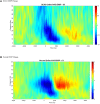Event-Related Desynchronization/Synchronization in Spinocerebellar Ataxia Type 3
- PMID: 31417491
- PMCID: PMC6684955
- DOI: 10.3389/fneur.2019.00822
Event-Related Desynchronization/Synchronization in Spinocerebellar Ataxia Type 3
Abstract
Introduction: Spinocerebellar ataxia type 3 (SCA3) is an autosomal dominant, cerebellar degeneration predominant disease caused by excessive CAG repeats. We examined event-related dysynchronization/synchronization (ERD/ERS) in patients with SCA3. Methods: We assessed ERD/ERS of self-paced voluntary hand movements in 15 patients with genetically proven SCA3 in comparison with healthy controls. Results: In ERS, a significant interaction effect between group, frequency, and period (F = 1.591; p = 0.005; ρI = 0.86) was observed. The post-hoc two-tailed independent t-test showed significant differences in high beta and low beta ERS. By contrast, in ERD, no apparent differences were observed in the pattern of patients with SCA3 in comparison with healthy controls (F = 1.01; p = 0.442). Conclusion: The study revealed a decreased ERS in patients with SCA3, especially at the frequency of 20-30 Hz. This study elucidates the significant role of cerebellum in motor control.
Keywords: ERD; ERS; SCA3; cerebellar ataxia; motor control.
Figures



References
LinkOut - more resources
Full Text Sources

